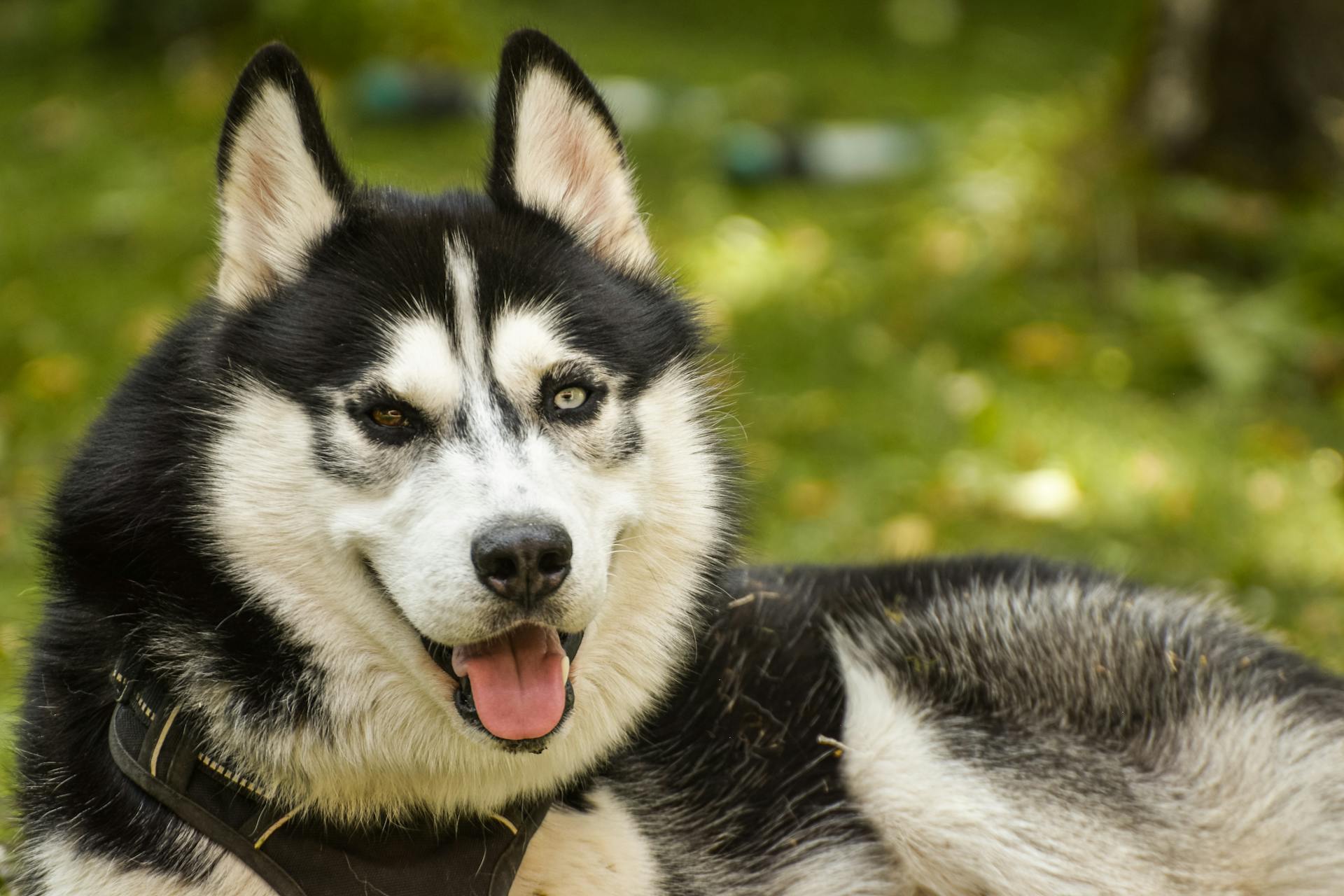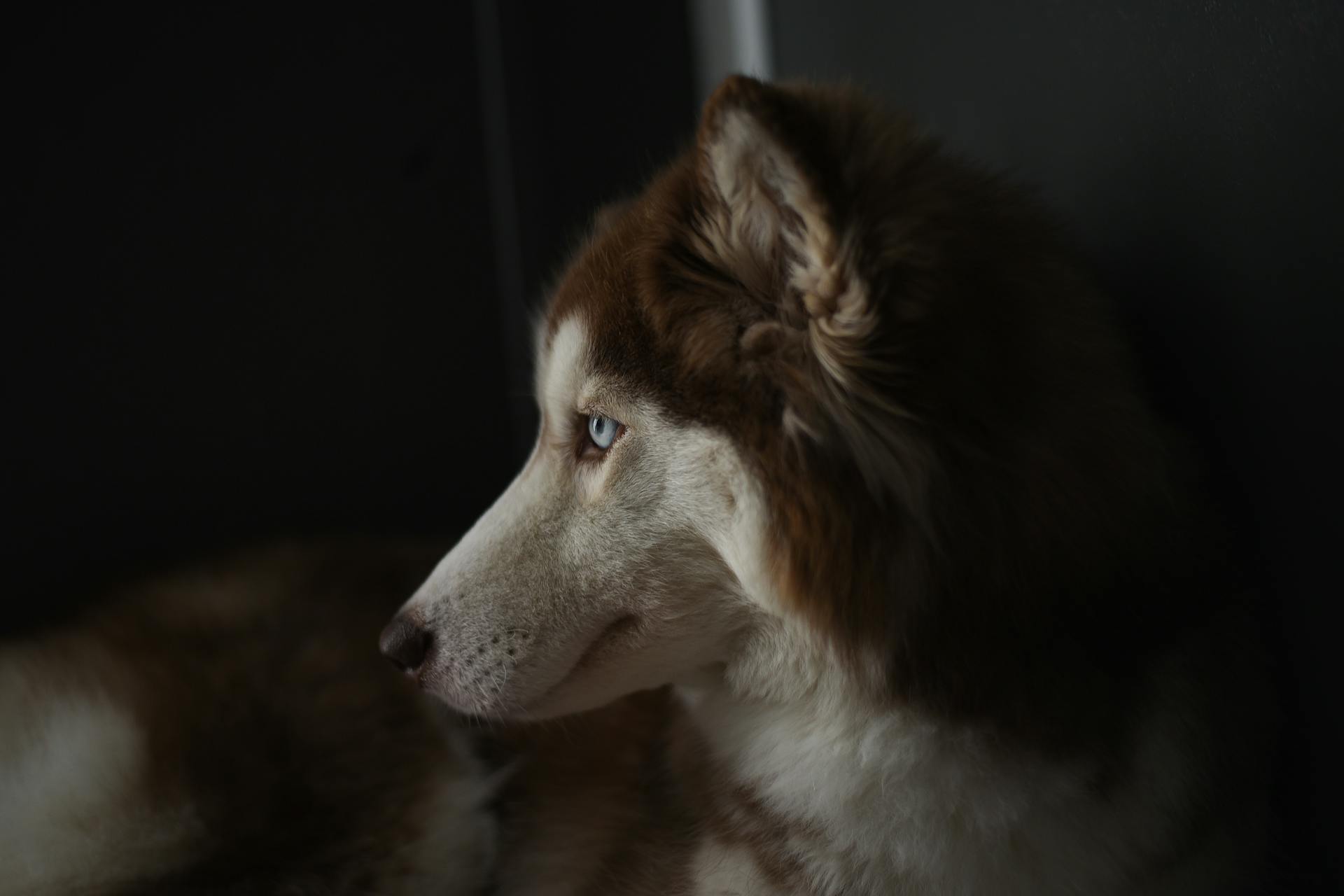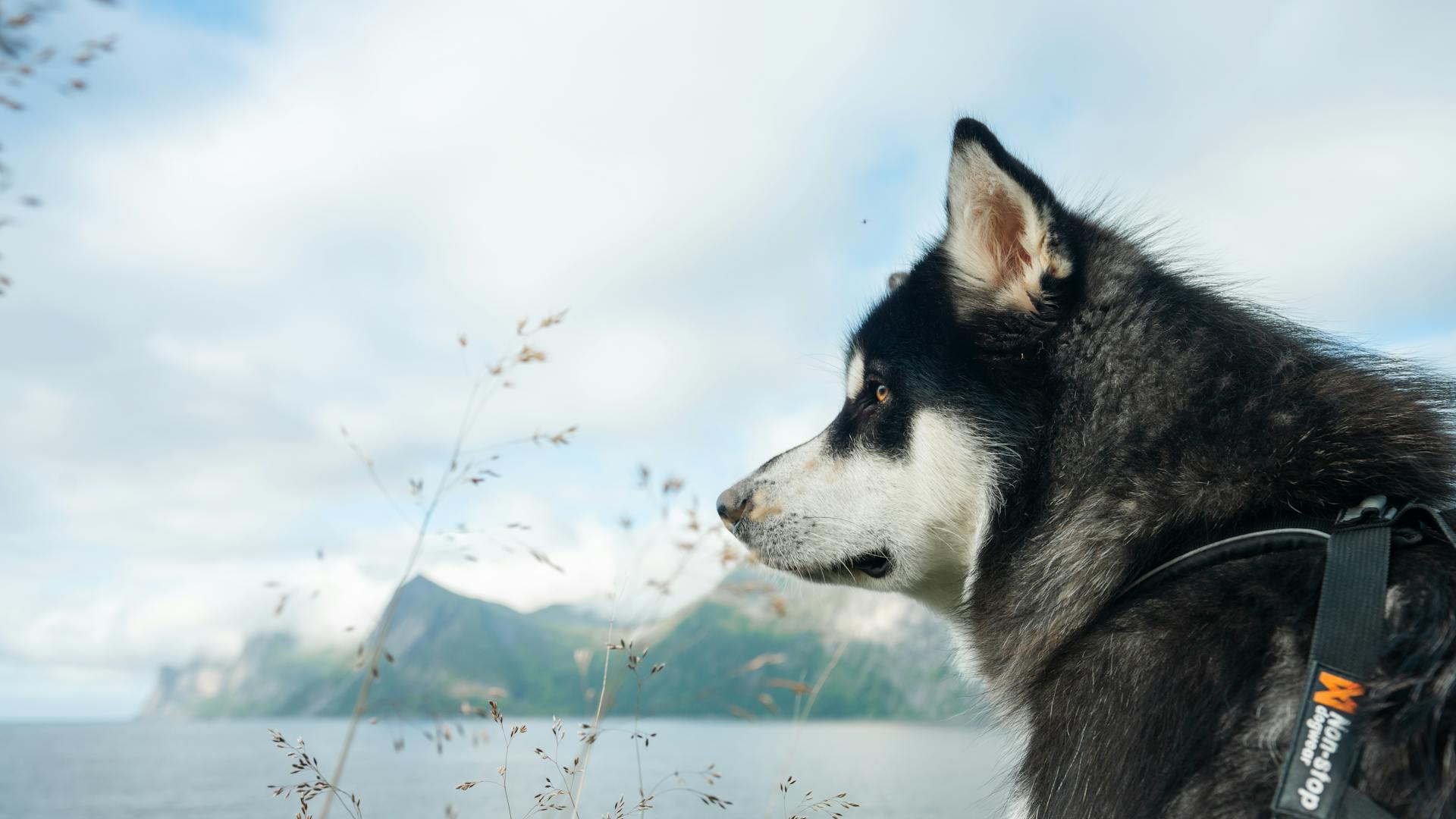
Husky dogs have a rich history that spans thousands of years, originating from Siberia where they were bred by the Chukchi people to help with hunting and transportation.
Their ancestors were likely wolves, and over time, they were domesticated and selectively bred for their unique characteristics.
Husky dogs are known for their striking appearance, with a thick double coat that helps them withstand the harsh Arctic climate.
Their eyes are typically blue or brown, and they can weigh between 35-60 pounds, depending on their size and breed.
Husky dogs are highly energetic and require regular exercise to stay happy and healthy, which is why they thrive in active families.
They are also highly intelligent and trainable, making them a popular choice for dog owners who want a loyal companion.
In the wild, husky dogs would typically run for miles each day, and they need to be exercised regularly to replicate this natural behavior.
Husky Traits
Huskies are extremely energetic and love to run, making them great jogging companions.
Their physical endurance is truly impressive, allowing them to keep up with even the most active owners.
Male huskies typically weigh between 45-60 pounds, while females weigh between 35-50 pounds.
Female huskies stand between 18-20 inches tall, while males stand between 21-24 inches tall.
Huskies have a thick double coat, which they shed heavily, so be prepared for regular brushing and vacuuming.
Their coat comes in a variety of colors, including white, black, silver, and red.
Huskies are highly social dogs and are quick to make friends with complete strangers.
They have high predatory instincts and may prey on smaller animals like squirrels and birds.
Here's a list of some of the colors you can expect to see in a husky's coat:
- White
- Agouti
- Black
- Piebald
- Black & Tan
- Splash
- Black & White
- Silver
- Red
- Copper
- Brown
- Sable
- Grey
Huskies are independent, athletic, and intelligent dogs, but they can be stubborn to train.
Coat Types and Colors
Siberian Huskies have a thick double coat that's perfect for withstanding harsh Arctic winters.
Their coat consists of a dense undercoat and a longer topcoat of short, straight guard hairs that require regular grooming.
This coat combination protects them from temperatures as low as −50 to −60 °C (−58 to −76 °F).
Siberian Huskies come in a variety of colors and patterns, often with white paws and legs, facial markings, and tail tip.
Black and white is the most common coat color, followed by copper-red and white, grey and white, pure white, and the rare "agouti" coat.
Their coats can also feature striking masks, spectacles, and other facial markings in a wide variety.
Regular grooming is necessary to prevent matting and tangling of their thick coats, and should be done weekly.
Their white markings, especially on the legs and chest, are a common feature among most members of the breed.
History and Lineage
The Siberian Husky has a rich history that dates back over 3,000 years to Northeast Asia, where the nomadic Chukchi tribe bred them to pull sleds and hunt reindeer.
Their ancestors were identified as "short-faced wolves" in a 1989 study of ancient canid remains found in Alaska. These remains were later found to be related to the Siberian Husky and other Arctic breeds.
The Chukchi people developed the Siberian Husky specifically for endurance sled pulling, and they were bred to be lightweight and efficient.
Genetic studies have confirmed that the Siberian Husky, Alaskan Malamute, and Alaskan Husky share a close genetic relationship with Chukchi sled dogs from Siberia.
The breed was introduced to Alaska in 1909 and gained popularity as a pet in 1925, after a heroic sled relay delivered life-saving serum to Nome during a diphtheria epidemic.
The Siberian Husky's genetic closeness to the Taymyr wolf of North Asia is due to admixture, which provided early dogs with beneficial phenotypic variation for adapting to high-latitude environments.
A 2015 study using genetic markers further confirmed the Siberian Husky's close genetic relationship with Chukchi sled dogs and its distinctiveness from Inuit dogs.
Suggestion: Alaskan Husky Sled Dog
Health and Care
Siberian Huskies are generally a healthy breed, but some genetic health issues can occur. They can live up to 14 years with proper care.
Hip dysplasia is a common condition in Huskies, where the hip joint doesn't develop properly. This can lead to arthritis and mobility issues.
Eye problems are also prevalent in the breed, including cataracts, progressive retinal atrophy, and corneal dystrophy. These conditions can cause vision loss and blindness.
A nutritious diet and regular exercise are essential to prevent or manage these health issues. Pet insurance is also a good idea to cover unexpected veterinary costs.
Here are some common health issues in Siberian Huskies:
- Hip dysplasia
- Eye issues (cataracts, PRA, corneal dystrophy)
- Hypothyroidism
- Von Willebrand’s Disease
- Pemphigus foliaceus
- Epilepsy
Health and Conditions
Siberian Huskies are generally a healthy breed, but some health issues can occur. The average life span of a Siberian Husky is 10 to 14 years.
Hip dysplasia is a common condition that can occur when the hip joint doesn't develop properly. Eye issues, such as cataracts, progressive retinal atrophy (PRA), and corneal dystrophy, are also prevalent.
Hypothyroidism occurs when the thyroid glands fail to produce adequate amounts of hormones. Von Willebrand’s Disease is a bleeding disorder caused by a deficiency in the protein needed for the blood to clot.
For more insights, see: What to Feed Dogs When You Run Out of Food

Pemphigus foliaceus is an autoimmune skin disease that can result in hair loss on the ears, nose, and footpads. Epilepsy is an inherited condition that tends to show up between three months and three years of age.
Here are some common health issues that can affect Siberian Huskies:
- Hip dysplasia
- Eye issues (cataracts, PRA, corneal dystrophy)
- Hypothyroidism
- Von Willebrand’s Disease
- Pemphigus foliaceus
- Epilepsy
Nose
When it comes to the nose of a Siberian Husky, show-quality dogs are preferred to have neither pointed nor square noses.
The nose color can vary depending on the dog's coat color, with black noses being typical in gray dogs, tan noses in black dogs, and liver-colored noses in copper-colored dogs.
In some cases, Siberian Huskies can develop a condition called "snow nose" or "winter nose", which is also known as hypopigmentation in animals. This condition is actually acceptable in the show ring.
You might enjoy: Black Husky Dogs
Lifespan
When you bring a Siberian Husky into your family, you're making a long-term commitment. They typically live from 12 to 15 years, with some even reaching the ripe age of 16.
Their lifespan is longer than many medium-sized breeds, which usually live between 10 and 13 years.
Discover more: Husky Mix Lifespan
Care Tips
Taking care of yourself is essential, especially when you're dealing with health issues.
Drink plenty of water throughout the day to stay hydrated, aiming for at least eight glasses.
Eating a balanced diet rich in fruits, vegetables, and whole grains can help your body recover from illness.
Exercise regularly, even if it's just a short walk each day, to improve circulation and reduce fatigue.
Get enough sleep each night, aiming for 7-8 hours, to help your body repair and recharge.
Taking breaks and practicing stress-reducing techniques, such as meditation or deep breathing, can help manage anxiety and promote overall well-being.
Exercise and Training
Siberian Huskies are extremely active and athletic dogs that require a lot of exercise to stay engaged.
They can excel at canine sports like rally, obedience, and agility, and daily walks or doggie playgroups can provide enough exercise for those living in urban settings.
A large, escape-proof yard is essential for Huskies to run around, and a daily run or jog on a leash is also recommended.
Here's an interesting read: How Much Exercise Do Husky Dogs Need
Early socialization is crucial for Huskies, especially if you want to minimize the prey drive, and firm, consistent training using positive reinforcement methods is vital.
Without adequate exercise, Huskies can develop problem behaviors like roaming, chewing, or nuisance barking, so it's essential to keep them busy and active.
A 6 ft fence is recommended for Huskies as pets to prevent them from escaping, and a fifteen-minute daily obedience training class has been shown to serve well for this breed.
Huskies are intelligent and friendly, but can be stubborn and may obey a command only if they see a point to it, so patience and understanding of sled-dog character are necessary for training.
They have a high prey drive due to their ancestors' history of hunting in packs, but with training, they can be trusted with other small animals.
Explore further: Huskies Good Apartment Dogs
Food & Diet
Huskies are unique dogs with specific dietary needs. They require a relatively small amount of food compared to other dogs of a similar size.
Adult Huskies typically need around 1,000 calories each day, split over two meals. This can vary depending on their activity level, but a general guideline is to feed them twice a day.
Be careful with cereals like wheat, as they can be hard for Huskies to digest. Some dog foods may contain wheat, so it's essential to choose a high-quality food that's gentle on their stomach.
Regular exercise is crucial for Huskies, as they have a naturally slow metabolism. Burning off energy helps stimulate their appetite, so make sure they get enough physical activity.
Their thick fur can make them prone to overheating, especially during summer months. Ensure your Husky has access to plenty of fresh water to stay hydrated.
Here's a rough guide to help you estimate your Husky's daily calorie needs:
Keep in mind that this is just a rough estimate, and your veterinarian can provide a more accurate calculation based on your Husky's individual needs.
Buying and Owning
Buying and owning a Husky requires careful consideration and preparation.
Huskies are highly intelligent, playful, and friendly dogs, but they need lots of active exercise, mental stimulation, and attention. They're best suited to dog owners with active lifestyles and plenty of time.
You'll need to start training early, be consistent, and find the right balance between firm and fair. This is because Huskies have a strong independent streak and a tendency for mischief.
Before getting a Husky, it's essential to assess the temperament of the parents and what breeding lines they are from. This will help you understand the puppy's potential behavior and needs. For example, a puppy bred from showing stock might be calmer and easier to manage than one descended from working dogs.
A high prey drive means Huskies are best kept on a lead during walks. They love exploring gardens, but they're expert escape artists with an ability to jump fences and dig holes. Any outdoor space must be safe and secure.
Additional reading: Best Dog Food for Gassy Dogs
Here are some key things to consider before buying or rehoming a Husky:
- Active exercise: at least 2 hours each day
- Mental stimulation and attention
- Training: start early, be consistent, and find the right balance between firm and fair
- Prey drive: keep on a lead during walks
- Outdoor space: safe and secure
If you're looking for a reputable breeder, check out the Siberian Husky Club of America's site for a referral directory of breeders.
General Information
Husky dogs are originally from Siberia, where they were bred to thrive in the harsh, cold climate. They're built for endurance and have a thick double coat to keep them warm.
Huskies are a medium to large breed, with males weighing between 45-60 pounds and standing 20-23.5 inches tall.
Their intelligence and high energy levels make them a great fit for active families who can provide plenty of exercise and mental stimulation.
Tail
The Siberian Husky's tail is a distinctive feature of the breed. It's typically carried high and curved, giving the dog a lively appearance.
Their tail is a great indicator of their mood, so pay attention to how it's held. If it's tucked between their legs, they might be feeling anxious or scared.
Husky owners often comment on the joy their dogs express with their wagging tails. It's a wonderful sight to see!
If you're interested in adopting a Husky, you can view the available dogs looking for a forever home!
Key Takeaways
Siberian Huskies have been around for about 3,000 years, developed by the Chukchi people of Siberia to be the ultimate sled dogs.
They're bred to be strong and highly tolerant to cold, which means they can survive on very little food.
Huskies are known for being friendly and outgoing, even with strangers, making them great family dogs, but not-so-good watchdogs.
This working breed needs plenty of training to become a well-mannered member of the family.
Siberian Huskies are a relatively healthy breed, but like all dogs, they can develop genetic health conditions such as Von Willebrand’s disease, hip dysplasia, and hypothyroidism.
Here are some potential health issues to be aware of:
- Von Willebrand’s disease
- Hip dysplasia
- Hypothyroidism
Your vet will be able to notice any problems and work with you to set up a preventive regimen that will help you avoid many health issues.
Final Thoughts
Siberian Huskies have a beautiful coat that requires regular grooming to prevent matting and tangling.

These dogs are known for their work ethic, which means they need regular exercise to stay happy and healthy.
Their friendly and mischievous expressions can be a joy to behold, but they also require consistent training to prevent behavioral issues.
Siberian Huskies are not for casual owners, as they need regular exercise, mental stimulation, and consistent training to thrive.
Your feedback matters, and it can help improve the lives of Siberian Husky owners and their pets.
Curious to learn more? Check out: Husky Dog Training
Frequently Asked Questions
How many types of husky dogs are there?
There are 23 types of husky dogs, with the American Kennel Club recognizing only one breed, the Siberian Husky. However, many other Northern breeds are colloquially referred to as "Husky", making for a diverse and fascinating group of dogs.
What is the rarest color husky?
The rarest color of Husky is a true white Husky, which has no markings besides white. This rare coloration is often accompanied by striking blue eyes.
Featured Images: pexels.com


